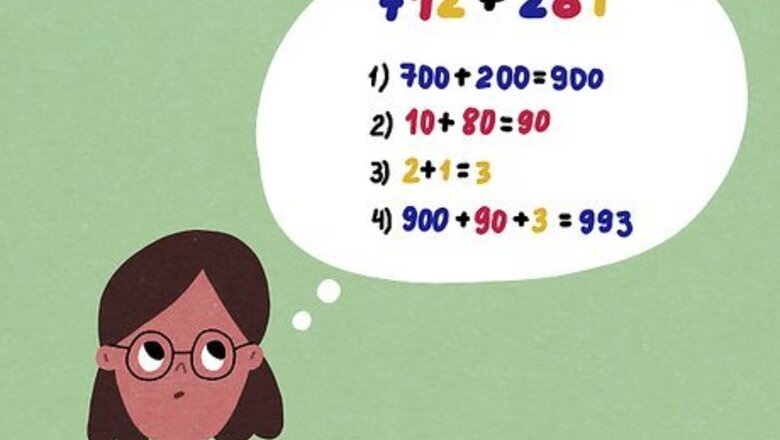
views
Break addition and subtraction problems into parts.

Add the hundreds, tens, and ones places separately. Treat each group as a separate problem: 712 + 281 → "700 + 200," "10 + 80," and "2 + 1" 700 + 200 = 900, then 10 + 80 = 90, then 2 + 1 = 3 900 + 90 + 3 = 993. Thinking in "hundreds" or "tens" instead of single digits will make it easier to keep track when digits sum to more than ten. For example, for 37 + 45, think "30 + 40 = 70" and "7 + 5 = 12". Then add 70 + 12 to get 82.
Change the problem to make round numbers.
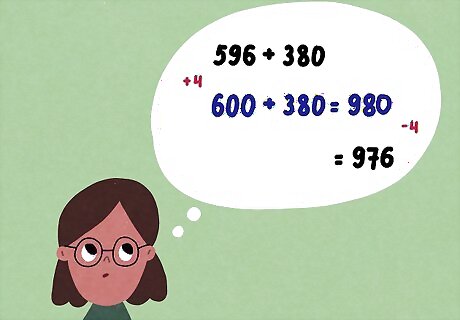
Adjust to get round numbers, then correct after the problem is done. Round numbers are much faster for most of us to work with. Keep a mental note of the changes you made so you can adjust to get the exact answer at the end. For example: Addition: For 596 + 380, realize that you can add 4 to 596 to round it to 600, then add 600 + 380 to get 980. Undo the rounding by subtracting 4 from 980 to get 976. Subtraction: For 815 - 521, break it up into 800 - 500, 10 - 20, and 5 - 1. To turn the awkward "10 - 20" into "20 - 20", add 10 to 815 to get 825. Now solve to get 304, then undo the rounding by subtracting 10 to get 294. Multiplication: For 38 x 3, you can add 2 to 38 to make the problem 40 x 3, which is 120. Since the 2 you added got multiplied by three, you need to undo the rounding by subtracting 2 x 3 = 6 at the end to get 120 - 6 = 114.
Learn to add many numbers at once.
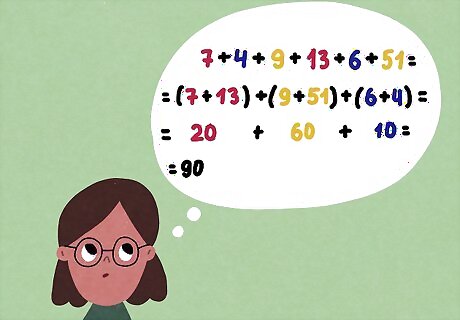
Reorder the numbers to make convenient sums. An addition problem is the same no matter what order you solve it in. Look for numbers that add up to 10 or other nice, round numbers: For example, 7 + 4 + 9 + 13 + 6 + 51 can be reorganized to (7 + 13) + (9 + 51) + (6 + 4) = 20 + 60 + 10 = 90.
Multiply from left to right.

Keep track of the hundreds, tens, and ones places. On paper, most people multiply the ones place first, going from right to left. But in your head, it's easier to go the other way: For 453 x 4, start with 400 x 4 = 1600, then 50 x 4 = 200, then 3 x 4 = 12. Add them all together to get 1812. If both numbers have more than one digit, you can break it into parts. Each digit has to multiply with each other digit, so it can be tough to keep track of it all. 34 x 12 = (34 x 10) + (34 x 2), which you can break down further into (30 x 10) + (4 x 10) + (30 x 2) + (4 x 2) = 300 + 40 + 60 + 8 = 408.
Try a fast multiplication trick best for numbers 11 through 19.
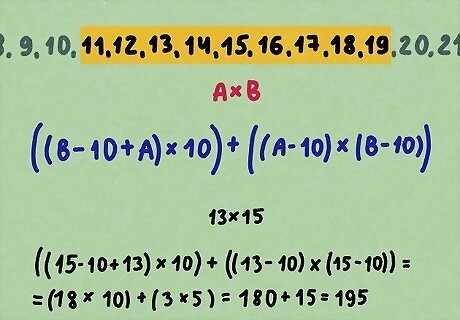
Try this method of turning one hard problem into two easier ones. This is another way of breaking a problem into parts. It can be a little tricky to remember at first, but once you have it down it can make multiplication much faster. This is easiest when multiplying two numbers that are both in the range of 11 to 19, but you can learn to use it for other problems: Let's look at numbers close to 10, like 13 x 15. Subtract 10 from the second number, then add your answer to the first: 15 - 10 = 5, and 13 + 5 = 18. Multiply your answer by ten: 18 x 10 = 180. Next, subtract ten from both sides and multiply the results: 3 x 5 = 15. Add your two answers together to get the final answer: 180 + 15 = 195. Careful with smaller numbers! For 13 x 8, you start with "8 - 10 = -2", then "13 + -2 = 11". If it's hard to work with negative numbers in your head, try a different method for problems like this. For larger numbers, it will be easier to use a "base number" like 20 or 30 instead of 10. If you try this, make sure you use that number everywhere that 10 is used above. For example, for 21 x 24, you start by adding 21 + 4 to get 25. Now multiply 25 by 20 (instead of ten) to get 500, and add 1 x 4 = 4 to get 504.
Simplify problems with numbers ending in zero.

If the numbers end in zeroes, you can ignore them until the end: Addition: If all numbers have zeroes at the end, you can ignore the zeroes they have in common and restore them at the end. 850 + 120 → 85 + 12 = 97, then restore the shared zero: 970. Subtraction works the same way: 1000 - 700 → 10 - 7 = 3, then restore the two shared zeroes to get 300. Notice that you can only remove the two zeroes the numbers have in common, and must keep the third zero in 1000. Multiplication: ignore all the zeroes, then restore each one individually. 3000 x 50 → 3 x 5 = 15, then restore all four zeroes to get 150,000. Division: you can remove all shared zeroes and the answer will be the same. 60,000 ÷ 12,000 = 60 ÷ 12 = 5. Don't add any zeroes back on.
Easily multiply by 4, 5, 8, or 16.
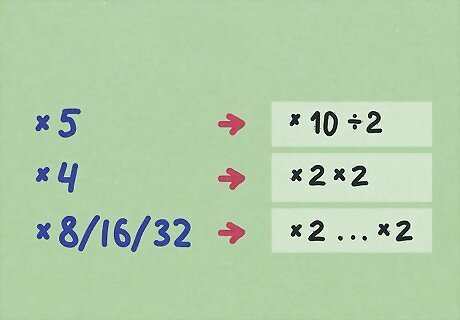
You can convert these problems so they only use 2s and 10s. Here's how: To multiply by 5, instead multiply by 10, then divide by 2. To multiply by 4, instead double the number, then double it again. For 8, 16, 32, or even higher powers of two, just keep doubling. For example, 13 x 8 = 13 x 2 x 2 x 2, so double 13 three times: 13 → 26 → 52 → 104.
Memorize the 11s trick.

You can multiply a two-digit number by 11 with barely any math. Add the two digits together, then put the result in between the original digits: What is 72 x 11? Add the two digits together: 7 + 2 = 9. Put the answer in between the original digits: 72 x 11 = 792. If the sum is more than 10, place only the final digit and carry the one: 57 x 11 = 627, because 5 + 7 = 12. The 2 goes in the middle and the 1 gets added to the 5 to make 6.
Turn percentages into easier problems.

Know which percentages are easier to calculate in your head. There are a couple useful tricks to know: 79% of 10 is the same as 10% of 79. This is true of any two numbers. If you can't find the answer to a percentage problem, try switching it around. To find 10% of a number, move the decimal one place to the left (10% of 65 is 6.5). To find 1% of a number, move the decimal two places to the left (1% of 65 is 0.65). Use these rules for 10% and 1% to help you with more difficult percentages. For example, 5% is ½ of 10%, so 5% of 80 = (10% of 80) x ½ = 8 x ½ = 4. Break percentages into easier parts: 30% of 900 = (10% of 900) x 3 = 90 x 3 = 270.
Memorize advanced multiplication shortcuts for specific problems.
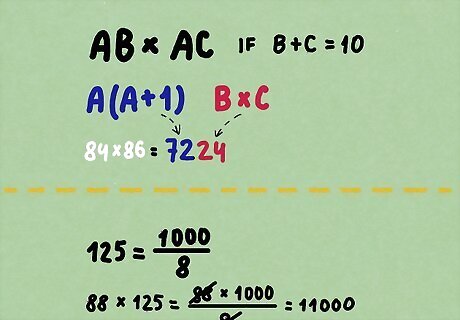
These tricks are powerful, but narrow. They can turn a seemingly impossible mental math task into a quick task, but will only work on a very small percentage of problems. Learn these if you are already pretty good at mental math and want to approach "mathemagician" levels of speed: For problems like 84 x 86, where the tens place is the same and the ones place digits sum to exactly 10, the first digits of the answer are (8 + 1) x 8 = 72 and the last digits are 4 x 6 = 24, for an answer of 7224. That is, for a problem AB x AC, if B + C = 10, the answer starts with A(A+1) and ends with BC. This also works for larger numbers if all digits besides the ones place are identical. You can rewrite the powers of five (5, 25, 125, 625, ...) as powers of 10 divided by an integer (10 / 2, 100 / 4, 1000 / 8, 10000 / 16, ...). So 88 x 125 becomes 88 x 1000 ÷ 8 = 88000 ÷ 8 = 11000.
Memorize squares charts.
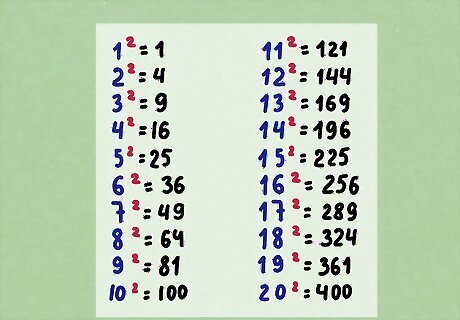
Squares charts give you a new way to multiply. Memorizing your multiplication tables from 1 to 9 makes single-digit multiplication automatic. But for larger numbers, instead of trying to memorize hundreds of answers, it's more efficient to memorize just the squares instead (each number times itself). With a little extra work, you can use these squares to find the answer to other problems: Memorize the squares from 1 to 20 (or higher, if you're ambitious). (That is, 1 x 1 = 1; 2 x 2 = 4; 3 x 3 = 9, and so on.) To multiply two numbers, first find their average (the number exactly between them). For example, the average of 18 and 14 is 16. Square this answer. Once you've memorized the squares chart, you'll know that 16 x 16 is 256. Next, look at the difference between the original numbers and their average: 18 - 16 = 2. (Always use a positive number here.) Square this number as well: 2 x 2 = 4. To get your final answer, take the first square and subtract the second: 256 - 4 = 252.
Find useful ways to practice your mental math.
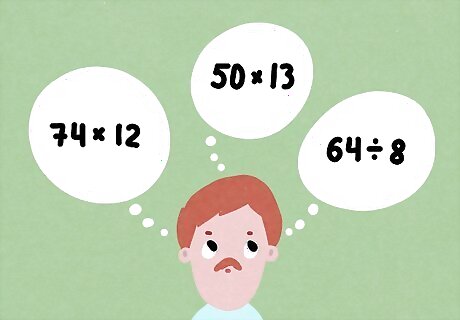
Daily practice will make a huge difference. If you want to increase your confidence and speed at mental math, make an effort to use those skills at least two or three times a day. These suggestions can help you make this practice more effective: Flashcards are great for memorizing multiplication and division tables, or for getting used to tricks for specific kinds of problems. Write the problem on one side and the answer on the other, and quiz yourself daily until you get them all right. Online math quizzes are another way to test your ability. Look for a well-reviewed app or website made by an educational program. Practice in everyday situations. You could add together the total of items you buy as you shop, or multiply the gas cost per volume by your car's tank size to find the total cost. The more of a habit this becomes, the easier it will be. EXPERT TIP Joseph Meyer Joseph Meyer Math Teacher Joseph Meyer is a High School Math Teacher based in Pittsburgh, Pennsylvania. He is an educator at City Charter High School, where he has been teaching for over 7 years. Joseph is also the founder of Sandbox Math, an online learning community dedicated to helping students succeed in Algebra. His site is set apart by its focus on fostering genuine comprehension through step-by-step understanding (instead of just getting the correct final answer), enabling learners to identify and overcome misunderstandings and confidently take on any test they face. He received his MA in Physics from Case Western Reserve University and his BA in Physics from Baldwin Wallace University. Joseph Meyer Joseph Meyer Math Teacher Exercise your mental math muscles. Improve your math skills by solving daily math problems without using calculators, paper, or counting aids. By solely using your mind and getting into math discussions with your classmates, you will refine your skills and discover new approaches to problem-solving.














Comments
0 comment